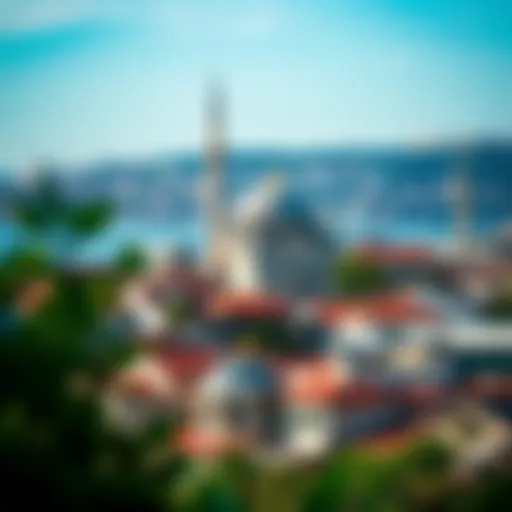Discovering the Old Town Souk: A Dubai Gem
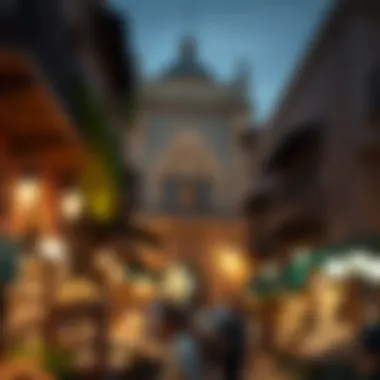

Intro
The Old Town Souk in Dubai serves as a cultural and commercial hub, reflecting centuries of trade and interaction between different peoples. Nestled alongside picturesque waterways and contemporary architecture, this souk encapsulates the heart of traditional market life while embracing the modern shopper's needs. Here, you’ll find everything from handwoven textiles to exotic spices, all offered in a vibrant atmosphere that sings of the region's rich heritage.
As we delve into the myriad aspects of this souk, we'll explore its deep historical roots, the eclectic mix of goods available for purchase, and its significance not only to shoppers but also to investors eyeing potential real estate opportunities in this burgeoning district. There's a lot to uncover, including insights into market conditions, future prospects, and why the Old Town Souk stands as a cornerstone for anyone considering a move or investment in this dynamic city.
Market Trends and Insights
Understanding the current market dynamics surrounding the Old Town Souk provides key insights that are valuable for various stakeholders, from individual buyers to seasoned investors.
Current Market Conditions
Examining the present landscape, one cannot overlook the upward trend in Dubai's tourism sector, which has significantly boosted foot traffic in this area. Picture yourself strolling through narrow alleys, where the scent of freshly roasted coffee mingles with wafts of saffron and cardamom. With such experiences drawing visitors, local businesses are witnessing a steady increase in demand.
- Foot Traffic Growth: Major festivals and events hosted nearby have given the area a boost. The souk can count on both locals and tourists to fill its winding paths.
- E-Commerce Impact: While online shopping continues to grow, physical marketplaces like the Old Town Souk still find their unique charm strong enough to entice shoppers who seek the tactile joy of browsing.
Future Predictions
Looking ahead, analysts predict that Dubai will continue capturing the world’s interest. The combination of tradition and innovation in the Old Town Souk may pave the way for future expansion projects that could further enhance its appeal.
- Increased Investment: With developers looking into mixed-use properties, the potential for new retail spaces around the souk becomes evident.
- Cultural Significance: As Dubai further enhances its identity through cultural initiatives, the souk could gain privileged status, becoming a must-visit attraction.
“As the Old Town Souk grows, so does its significance to both local communities and international investors.”
Investment Opportunities
For those considering property investment in the vicinity of the Old Town Souk, several factors warrant attention. Identifying prime locations and understanding the types of properties available can facilitate sound investment decisions.
Locations to Consider
When narrowing down where to invest, keep some key areas in mind. Notably, these neighborhoods significantly align with the soul of the Old Town Souk, offering proximity to both cultural hotspots and potential growth areas.
- Al Fahidi Historical Neighborhood: Rich in culture and history, it's a stone's throw from the souk, attracting both tourists and locals.
- Dubai Creek District: Known for its waterfront developments, this area promises striking views and modern amenities.
Types of Properties Available
Real estate options vary widely in this vibrant area, reflecting a fusion of traditional charm and modern conveniences.
- Residential Units: Ranging from quaint studios to luxury apartments, these spaces cater to diverse tastes and budgets.
- Commercial Spaces: Ideal for entrepreneurs looking to tap into the local market, these shops could capitalize on the surge of visitors drawn to the souk.
By keeping an eye on the traditional charm of the Old Town Souk and its surrounding areas, investors can navigate this lively marketplace with confidence, making informed choices that align with their long-term strategies.
Foreword to the Old Town Souk
The Old Town Souk stands as a pulsating heart of Dubai, interweaving the city's vibrant past with its dynamic present. Here, visitors are swept into a tapestry of sights and sounds, each stall echoing stories of culture, tradition, and commerce. This section illuminates the significance of the souk, not just as a marketplace but as an emblem of Dubai's relentless evolution and a space where history resonates.
The Old Town Souk is more than a shopping destination; it serves as a significant connector of diverse cultures and communities. Traders and artisans, each with their own heritage, come together to create an environment rich in authenticity and local flavor. It is here that one can witness an array of goods, from handcrafted textiles to aromatic spices, providing a sensory journey that goes beyond mere transactions.
Understanding the souk's essence is vital for anyone interested in penetrating Dubai's real estate landscape. As developers eye this area for its investment potential, recognizing the role of the marketplace can aid in understanding local demographics and consumer behavior. With that in mind, this article delves deeper into its historical context and cultural significance, laying the groundwork for a holistic exploration of the Old Town Souk.
Historical Context
The Old Town Souk's roots stretch deep into the annals of Dubai's history, where the hustle and bustle of trade began centuries ago. Originally, the area was a vital hub for merchants taking advantage of the city's strategic geographical position along trade routes. From textiles to precious spices, the souk bridged East and West, facilitating economic interactions that laid the groundwork for Dubai's financial ascent.
Over the years, the souk has endured numerous transformations. One noteworthy phase came with the oil boom of the late 20th century, which ushered in modernization. However, despite the rapid developments surrounding it, the souk has maintained its historical architecture, giving visitors a glimpse into its rich lineage.
The architectural styles reflect various influences—from traditional Arabic designs to more contemporary facets introduced over time. As you walk through its narrow alleys and bustling corridors, you can feel the whispers of traders from generations past, making it a living museum of sorts.
Cultural Significance
The cultural tapestry woven within the Old Town Souk is nothing short of remarkable. It stands not merely as a marketplace but also as a social and cultural nexus where traditions continue to thrive. Each item sold has a story; whether it’s the intricate patterns of textiles or the carefully blended spices, the goods provide insights into local customs and lifestyles.
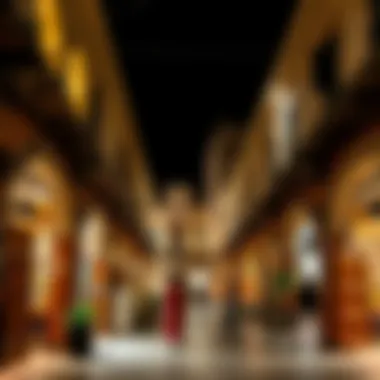

The souk hosts various cultural events and festivals, showcasing local art, music, and cuisine, making it a vibrant center for community engagement. Visitors don't just shop; they experience a convergence of interactions, where the laughter of children and the chatter of friendly haggling create an atmosphere like no other.
Moreover, the Old Town Souk embodies the ongoing dialogue between tradition and modernity. While it proudly showcases Dubai's rich heritage, it also adapts by incorporating contemporary values, attracting a diverse clientele. This balance bolsters its relevance in an ever-evolving city, ensuring that the local culture remains palpable, even as skyscrapers rise nearby.
In the next sections, we will further dissect the architectural elements and shopping experiences within the Old Town Souk, highlighting its enduring significance in Dubai's landscape.
Architectural Features
The architectural features of the Old Town Souk are fundamental to understanding its charm and allure. The combination of modern elements fused with traditional designs creates a unique character that draws visitors seeking both aesthetic pleasure and a sense of history. Not only does this architecture reflect the cultural journey of Dubai, but it also offers practical benefits for businesses and tourists alike.
Blend of Traditional and Modern Design
In the Old Town Souk, one can witness how contemporary and traditional designs intertwine like threads in a tapestry. The narrow, winding alleys embody the spirit of ancient marketplaces, reminiscent of the bustling trade centers of the past.
Materials play a big role in this contrast. While sleek glass facades indicate modernity, the terracotta tiles and wooden trellises nod to the rich history of Gulf architecture. This blend creates a visually stunning experience, enhancing the ambiance for shoppers and wanderers. The use of natural light is masterfully achieved through expansive, arched windows, maintaining a bright, inviting atmosphere while staying true to the architectural roots.
Advantages of this architectural fusion include:
- Enhanced Visitor Experience: The varied aesthetic keeps the environment engaging and immersive.
- Durability and Practicality: Contemporary materials, when combined with traditional styles, often prove to be more sustainable and easier to maintain.
- Cultural Narrative: Each structure tells a story, bridging the past and present, which resonates deeply with both locals and tourists.
Notable Landmarks Within the Souk
The Old Town Souk is home to several notable landmarks that showcase the artistry of its architecture. One such landmark is the Dubai Creek, which acts as a natural divide and has been central to commerce for centuries. Another highlight is the Heritage Village, where visitors can experience the essence of Emirati life through its style and layout, designed to mimic older trading hubs.
In addition to these sites, the souq’s many distinct entrances—characterized by intricately carved wooden doors—serve as an invitation to explore the interior further. These architectural features not only facilitate accessibility but also guide visitors through the maze of stalls filled with exotic goods.
The careful preservation and enhancement of these landmarks are essential in maintaining the soul of the Old Town Souk amidst ongoing development.
Understanding the architectural nuances in the Old Town Souk provides visitors with a deeper appreciation of not just what they see, but of the culture and history that shaped Dubai.
All in all, the architectural features of the Old Town Souk are more than mere aesthetic choices. They forge connections—between people, history, and the vibrant market life of today. As investors and real estate agents consider the surrounding properties, the unique blend of designs in the Souk stands as an enticing backdrop for potential opportunities.
Shopping Experience in the Old Town Souk
A visit to the Old Town Souk is like stepping into a vibrant tapestry woven from the threads of history and culture. The shopping experience here transcends mere consumerism; it is an immersion into the heart of Dubai's rich heritage. The juxtaposition of traditional and modern, old-time commerce and contemporary trends, makes this souk a highlight for visitors and a key point of interest for anyone considering the economic fabric of the area. It is not just about buying; rather, it’s an opportunity to engage with artisans, understand local customs, and navigate a market where every stall tells a story.
Types of Goods Available
Traditional Crafts
Traditional craftsmanship is at the soul of the Old Town Souk. Each handmade item—from ornate carpets to intricate ceramics—reflects the skill and dedication of local artisans. A standout feature of traditional crafts is their storytelling aspect; many pieces are deeply rooted in cultural symbolism or local lore, making them not just items, but conversation starters. For instance, a beautifully woven rug may not only serve as a decorative piece but also carry ancestral patterns that echo the history of the region.
Investing in such crafts offers a unique benefit: you bring home a piece of the culture while supporting local artists and their families. But one must be cautious; it’s essential to verify authenticity, as reproductions can sometimes masquerade as genuine handicrafts.
Spices and Textiles
Spices are the unsung heroes in the Old Town Souk’s bustling atmosphere, filling the air with rich aromas that beckon passersby. Whether it’s saffron, za’atar, or frankincense, the spice stalls are a treasure trove that not only introduces visitors to the tastes of the region but also serves as a reminder of trade routes that have existed for centuries. The texture and colors of textiles, from flowing silks to hand-loomed cottons, add to the sensory experience.
Textiles in particular are advantageous for those keen on finding unique souvenirs. They often come with stories of their origin and use. However, customers should keep an eye out for fair pricing, as these goods vary widely in quality and ethical sourcing.
Gold and Jewelry
Gold and jewelry shopping in the Old Town Souk can feel like a treasure hunt where the glittering displays dazzle the senses. The hallmark of this market is the 22K gold that is reputed for its quality. Jewelry pieces often feature intricate designs that hark back to centuries-old traditions, making them as much art as they are adornment.
Purchasing gold here provides an opportunity not just to acquire beauty, but also to invest in a valuable asset. However, potential buyers should be mindful of the pricing trends and market fluctuations. Familiarizing oneself with gold prices can save some serious money and ensure a good investment, especially for those looking to capitalize on the burgeoning real estate landscape surrounding the souk.
Bargaining Etiquette
Bargaining is an integral part of shopping in the Old Town Souk, and engaging in this practice requires some finesse. It’s not about haggling aggressively; rather, it is perceived as a dance between buyer and seller, where respect and humor can build rapport. A good tip is to start the negotiation lower than your target price but not too low as to offend.
It's common for vendors to expect some back-and-forth before arriving at a price. For example, if a seller quotes ten dollars for an item, you could counter with seven, allowing the negotiation to unfold naturally. Moreover, being polite and taking the time to engage in conversation with the seller creates a positive environment for both parties involved. This enhances the shopping experience while also building a connection to the local culture.
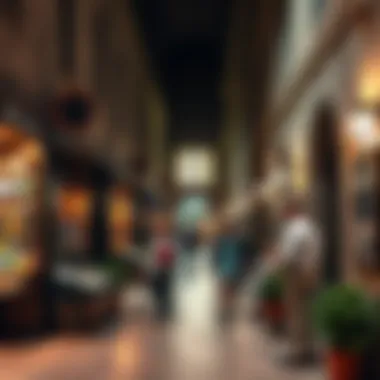

In essence, the shopping experience at the Old Town Souk is more than just a commercial venture; it is an immersion into the local culture, supported by the evolving real estate opportunities in the area.
Dining Options
Dining options in the Old Town Souk play a pivotal role in enhancing the overall experience for visitors and locals alike. The combination of local cuisine, street food, cafés, and restaurants captures the essence of Dubai's culinary landscape while simultaneously supporting the economy and fostering social interactions.
Culinary Highlights
Local Cuisine
The local cuisine within the Old Town Souk is a treasure trove of flavors and textures, reflecting the diverse cultural influences that make up Dubai's identity. Dishes like shawarma and falafel offer tourists a taste of authentic Middle Eastern food that is hard to resist. The key characteristic of local cuisine here is its emphasis on spices, vibrant aromas, and a freshness that speaks volumes.
This type of food is not just popular; it’s practically a rite of passage for anyone who dares to visit the souk. Diners often find that local flavors echo in every bite, a theme that resonates with the bustling atmosphere of the market. The unique feature of local cuisine is its ability to cater to various dietary preferences; whether someone is a meat lover or a vegetarian, there’s something to satiate the palate. However, part of the charm lies in the sometimes spicy nature of these dishes, which can be a bit of a gamble for the unaccustomed palate.
Street Food
The street food scene in the Old Town Souk is a stroke of genius, offering delectable options that are both affordable and rich in flavor. From kebabs sizzling on a grill to pita stuffed with fresh greens and savory meats, the variety is staggering. The key characteristic of street food in this area is its accessibility; you can grab a quick bite while strolling through the vibrant market stalls, making it not just a meal, but an experience.
Street food has become a popular choice for both visitors and locals, largely due to its combination of quality and affordability. You can find everything from samosas to karak chai in various nooks throughout the souk. The unique feature of street food is its immediacy; these quick eats can be devoured on the go, ideal for those who prefer to soak in the atmosphere rather than sit down. However, a downside is that the quality can vary between vendors, so it's always wise to observe the lines and customer reactions before choosing where to eat.
Cafés and Restaurants Within the Souk
Within the winding alleys of the Old Town Souk, numerous cafés and restaurants present a delightful contrast to the bustling market stalls. These establishments offer a respite from the chaos, often featuring stunning views of the waterways and stunning architectural elements of the souk. From traditional Arabic coffee to international fare, the dining options here cater to a wide range of tastes and preferences.
Café culture plays a substantial role, where locals often gather to share stories over cups of coffee. The ambiance typically leans toward casual, making it an inviting place for families and tourists. Restaurants, on the other hand, can vary from upscale dining experiences showcasing modern Middle Eastern cuisine to cozy spots that serve family recipes passed down through generations.
For anyone interested in a full experience, a meal in one of these cafés or restaurants provides the perfect blend of food, culture, and community, ensuring visitors leave with not just souvenirs, but rich memories.
Local Art and Culture
Local art and culture stand as a vibrant testament to the heart and soul of the Old Town Souk. This area is not merely a marketplace; it serves as a hub for creativity, skill, and community spirit. For art enthusiasts, it's a dynamic space where tradition dances with modern expression, offering more than just souvenirs but a real glimpse into the local heritage. Visitors can immerse themselves in a living gallery, experiencing the art forms that have been passed down through generations.
Artisan Workshops and Demonstrations
Walking through the souk, one frequently encounters artisan workshops tucked into corners filled with the scent of spices and the sound of chatter. These workshops highlight the remarkable craftsmanship prevalent in the region. From intricate pottery to delicate glassworks, every piece tells a story.
Participants can often observe demonstrations, such as traditional weaving or pottery-making. Take, for instance, an artisan skillfully molding clay while explaining his techniques; it's both an art form and a way to connect with one’s roots.
- Pottery Making: Visitors can observe artisans shaping clay into functional and decorative items.
- Weaving Textiles: Watch as colorful threads transform into stunning tapestries.
- Calligraphy: Experience the ancient tradition of Arabic calligraphy, learning about its significance and beauty.
These workshops are not merely exhibitions but are essential in keeping these traditions alive, while allowing a new generation to appreciate and learn these skills. Engaging with artisans enables a deeper understanding of the cultural richness that defines the Old Town Souk.
Cultural Events and Festivals
The Old Town Souk is a living entity that morphs itself during various cultural events and festivals. These occasions serve to galvanize the community and draw visitors into the fold of local practices.
Festivals often celebrate significant cultural milestones and public holidays, weaving history with contemporary practices. They include:
- Eid Celebrations: Colorful markets spring to life during Eid, offering unique local delicacies and traditional attire.
- Art Exhibitions: Local artists are given a platform to showcase their artistry, merging contemporary notions with traditional roots.
- Cultural Performances: Traditional dance performances and music resonate throughout the alleys, bringing vibrancy to the already bustling atmosphere.
These events foster connections amongst community members while inviting an appreciation for the diverse customs and practices that inhabit the Old Town Souk. They encapsulate how the souk does not just serve as a market but is a vibrant embodiment of the fabric that weaves together Dubai’s rich culture and history.
In essence, the art and culture of the Old Town Souk act as a bridge, linking the past to the present. Through artisan workshops and lively cultural events, both residents and visitors can engage in an impactful dialogue with the rich tapestry of the emirate’s heritage.
By understanding these elements, real estate agents, investors, and buyers can appreciate not only the physical properties but the cultural weight these surroundings hold, making the area a prime consideration for investment.
Real Estate Landscape Around the Old Town Souk
The area surrounding the Old Town Souk in Dubai is notable for its vibrant real estate landscape. This location acts as a focal point for various stakeholders, which include buyers, investors, and renters. Knowing the dynamics of this real estate scene is crucial for understanding the broader implications of market movements, local developments, and investment potentials.
Investment Opportunities
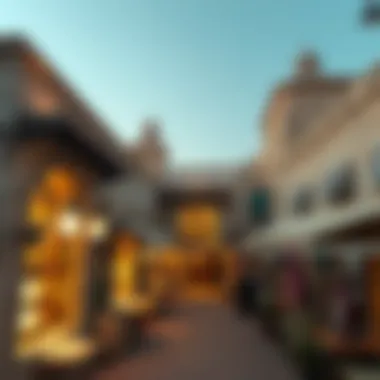

In recent years, the neighborhood around the Old Town Souk has garnered interest from both local and foreign investors. The appeal lies in several factors:
- Cultural Significance: The proximity to the Souk means investors can capitalize on tourism, as visitors flock to experience the rich culture and heritage.
- Development Projects: Several upcoming projects promise modern amenities while respecting the traditional charm of the souk. This can translate into increased rental income for investors.
- Mixed-Use Real Estate: Properties that blend commercial and residential aspects are gaining traction. Investors have the opportunity to purchase units that cater to both tourists and long-term residents, maximizing ROI.
For instance, a recent development, The Address Residences, offers high-end apartments that appeal to both buyers wanting a luxury lifestyle and investors looking for rental returns.
"Location is everything. The Old Town Souk is a prime spot that could push property values up, especially with ongoing developments."
Property Trends and Pricing
The property trends around the Old Town Souk reflect a segment of the market that is both competitive and diverse. Recent data indicate a steady rise in property prices, driven largely by demand among expatriates and tourists.
- Price Points: Current property prices can range significantly. For example, a one-bedroom apartment can go for around AED 1 million, while more luxurious options exceed AED 3 million.
- Rental Market: The rental market displays strong demand due to the location's appeal. Rental yields often hover around 7% annually, which is quite attractive. Investors should also note a growing trend toward short-term rentals, favored by tourists seeking authentic experiences in the area.
- Comparative Analysis: Comparing properties within a five-mile radius shows that prices can vary, but the trend remains upward due to increasing tourist footfall and local amenities.
In summary, the real estate landscape around the Old Town Souk is thriving. Considerations like investment opportunities, property pricing, and future developments make it a critical area for anyone looking to dive into Dubai's property market. Those who navigate this landscape well can find rewarding opportunities with a blend of culture and modernity.
Visitor Information
Understanding the visitor information regarding the Old Town Souk in Dubai is paramount for anyone planning a trip to this bustling marketplace. It provides essential insights into how to navigate the souk effectively, ensuring that visitors can experience its charm without a hitch. With a mix of traditional and modern elements, the souk presents a unique atmosphere that can be appreciated fully when one is well-prepared.
Opening Hours and Accessibility
The Old Town Souk generally welcomes visitors from early morning until late evening. Typical opening hours are from 10 AM to 10 PM on weekends and from 10 AM to 9 PM on weekdays. However, it's wise to check local listings or the official website because timings can vary, especially during religious holidays like Ramadan.
Accessibility is another vital factor when considering a visit. The souk is conveniently located near the Dubai Mall and is well-served by public transport, including the Dubai Metro and numerous bus routes. For those opting for a private vehicle, ample parking facilities are usually available nearby. Moreover, the design of the souk embraces a pedestrian-friendly approach, so guests can stroll leisurely without the worry of traffic.
"The Old Town Souk is crafted for exploration; its winding alleyways and delightful shops draw visitors in, promising an immersive experience."
Tips for First-Time Visitors
For first-time visitors to the Old Town Souk, a little preparation can go a long way. Here are several suggestions to help make the most of your visit:
- Plan Your Time: Allocate a few hours. The souk's ambiance and offerings entice visitors to linger, so having time on your hands can lead to unexpected discoveries.
- Dress Comfortably: The weather in Dubai can be quite warm, so breathable clothing and comfortable shoes are advisable for wandering long distances.
- Engage with Local Vendors: Part of the charm is interaction. Don't be shy; ask sellers about their products, as many are happy to share their stories and techniques, adding depth to your understanding.
- Practice Your Bargaining Skills: Negotiating prices is expected here. It's part of the culture! Approach it lightly—keep the conversation friendly and respectful.
- Stay Hydrated: Whether it's the warm sun or the bustling crowd, hydration is essential. Keep a bottle of water with you to avoid fatigue during your explorations.
In summary, visitor information serves as an essential navigation tool, equipping travelers with an understanding of opening hours, accessibility, and practical tips that enhance their enjoyment in the Old Town Souk. The experience awaits—make sure you're ready to dive in.
Sustainability Initiatives
Sustainability has found its way into modern-day markets, and the Old Town Souk is no exception. This vibrant area reflects not only cultural heritage but also a commitment to maintaining environmental integrity. As urban growth encroaches upon traditional spaces, sustainability becomes vital to ensure that the soul of the souk remains intact. By embracing eco-friendly practices, the Souk aims to foster community spirit, protect biodiversity, and enhance the overall shopping experience for everyone involved.
Eco-Friendly Practices in the Souk
When walking through the Old Town Souk, you may notice several signs of sustainable practices knitted throughout its fabric. For example, many shops are making the shift from plastic bags to biodegradable alternatives. This small yet significant change is part of a broader strategy aiming to significantly reduce plastic waste. Moreover, merchants have begun to utilize eco-friendly packaging, reinforcing their commitment to environmental responsibility.
Another notable aspect is the use of energy-efficient lighting within the souk. Vendors are transitioning to LED lights, which consume less energy and generate less heat compared to traditional lighting. This practice not only lowers electricity bills for shop owners but also contributes to a reduction in the souk's carbon footprint.
In addition, some stall owners are sourcing their materials from local artisans, minimizing transportation emissions and supporting the local economy. By prioritizing local sourcing, the Old Town Souk becomes more than just a marketplace—it transforms into a community hub that nurtures local craftsmanship while embodying sustainable practices.
Impact on the Local Community
The sustainability initiatives in the Old Town Souk extend far beyond reducing waste and energy consumption. They play a pivotal role in fostering a sense of community. As the souk adopts greener practices, it prompts locals and visitors alike to engage in discussions about environmentalism and preservation.
These practices can also lead to increased foot traffic, as eco-conscious shoppers are drawn to venues that reflect their values. A bustling market that echoes sustainability signals to potential buyers and investors that the area is a progressive neighborhood worth exploring. Consequently, many local residents find new economic opportunities in these evolving dynamics.
Furthermore, sustainability in the souk promotes a healthier living environment. By reducing pollution and focusing on local products, the community benefits from improved air quality and a more vibrant ecosystem. All these factors contribute to a greater sense of pride in the neighborhood.
Investing in sustainable practices is not merely a trend; it's a commitment to the future—of our planet and of the communities that inhabit it.
Ending
The Old Town Souk holds more than just a vibrant shopping experience; it’s a microcosm of Dubai’s rich heritage and modernity all wrapped in one. The importance of this topic lies in its multifaceted nature, offering insights that appeal not just to casual visitors, but also to potential investors and stakeholders in the real estate sphere. Exploring the souk can serve as a significant touchpoint for understanding the cultural ethos of Dubai while also assessing the economic vitality of adjacent areas.
In reflecting on the Old Town Souk experience, one must consider how it serves as a bridge between the past and the present. The exquisite craftsmanship found in traditional crafts and the engaging atmosphere foster connections that resonate deeply with both tourists and locals. This dynamic marketplace is a sensory feast, showcasing the aroma of spices, the shimmer of handmade jewelry, and the intricate patterns of textiles. The vitality of the souk not only enhances Dubai's tourism profile but also creates a vibrant backdrop for businesses poised to benefit from cultural tourism.
"The Old Town Souk is a living gallery, showcasing creativity that flourishes amidst modern skyscrapers."
Looking to the future of the Souk in a changing Dubai, it’s essential to note the ongoing developments in the area, particularly with respect to urban planning and real estate investments. As Dubai evolves, the preservation of such historical sites becomes paramount. Investors should keep an eye on property trends nearby, as increasing foot traffic and a growing appreciation for cultural tourism can drive up real estate values. Moreover, the commitment to sustainability in this area could further enhance its allure for future buyers. The potential for both growth and preservation exists in tandem, promising a bright future for the Old Town Souk as a cornerstone of the Dubai experience.
Ultimately, this article serves as a clarion call to delve deeper into the Old Town Souk, appreciating it as not just a marketplace, but a vital thread woven into the fabric of Dubai’s complex identity. Each visit offers a new discovery, and for those looking to invest or engage with this unique local culture, the souk stands ready with open arms.







